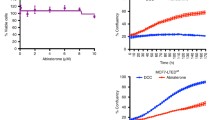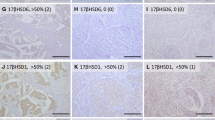Abstract
The aromatase inhibitors (AIs) are used to treat estrogen receptor-positive (ER+) breast tumors in post-menopausal women, and function by blocking the conversion of adrenal androgens to estrogens by the enzyme CYP19 aromatase. Breast cancer patients receiving AI therapy have circulating estrogen levels below the level of detection; however, androgen concentrations remain unchanged. We were interested in studying the effects of androgens on breast cancer cell proliferation under profound estrogen-deprived conditions. Using in vitro models of estrogen-dependent breast cancer cell growth we show that the androgens testosterone and 5α-dihydrotestosterone induce the growth of MCF-7, T47D and BT-474 cells in the absence of estrogen. Furthermore, we demonstrate that under profound estrogen-deprived conditions these breast cancer cells up-regulate steroidogenic enzymes that can metabolize androgens to estrogens. Lastly, we found that the downstream metabolite of 5α-dihydrotestosterone, 5α-androstane-3β,17β-diol (3βAdiol), is estrogenic in breast cancer cells, and induces growth and ER-signaling via activation of ERα. In conclusion, our results show that breast cancer cells deprived of estrogen up-regulate steroidogenic enzymes and metabolize androgens to estrogen-like steroids. The generation of estrogen-like steroids represents a potential mechanism of resistance to aromatase inhibitors.





Similar content being viewed by others
Abbreviations
- ER:
-
Estrogen receptor
- 3βAdiol:
-
5α-androstane-3β,17β-diol
- AI:
-
Aromatase inhibitor
- E2:
-
17β-estradiol
- TS:
-
Testosterone
- DHT:
-
5α-dihydrotestosterone
References
Macedo LF, Guo Z, Tilghman SL, Sabnis GJ, Qiu Y, Brodie A (2006) Role of androgens on MCF-7 breast cancer cell growth and on the inhibitory effect of letrozole. Cancer Res 66(15):7775–7782. doi:10.1158/0008-5472.CAN-05-3984
Iveson TJ, Smith IE, Ahern J, Smithers DA, Trunet PF, Dowsett M (1993) Phase I study of the oral nonsteroidal aromatase inhibitor CGS 20267 in postmenopausal patients with advanced breast cancer. Cancer Res 53(2):266–270
Santen RJ, Demers L, Ohorodnik S, Settlage J, Langecker P, Blanchett D et al (2007) Superiority of gas chromatography/tandem mass spectrometry assay (GC/MS/MS) for estradiol for monitoring of aromatase inhibitor therapy. Steroids 72(8):666–671. doi:10.1016/j.steroids.2007.05.003
Winer EP, Hudis C, Burstein HJ, Wolff AC, Pritchard KI, Ingle JN et al (2005) American Society of Clinical Oncology technology assessment on the use of aromatase inhibitors as adjuvant therapy for postmenopausal women with hormone receptor-positive breast cancer: status report 2004. J Clin Oncol 23(3):619–629. doi:10.1200/JCO.2005.09.121
Iveson TJ, Smith IE, Ahern J, Smithers DA, Trunet PF, Dowsett M (1993) Phase I study of the oral nonsteroidal aromatase inhibitor CGS 20267 in healthy postmenopausal women. J Clin Endocrinol Metab 77(2):324–331. doi:10.1210/jc.77.2.324
Lipton A, Demers LM, Harvey HA, Kambic KB, Grossberg H, Brady C et al (1995) Letrozole (CGS 20267). A phase I study of a new potent oral aromatase inhibitor of breast cancer. Cancer 75(8):2132–2138. doi :10.1002/1097-0142(19950415)75:8≤2132::AID-CNCR2820750816≥3.0.CO;2-U
Birrell SN, Bentel JM, Hickey TE, Ricciardelli C, Weger MA, Horsfall DJ et al (1995) Androgens induce divergent proliferative responses in human breast cancer cell lines. J Steroid Biochem Mol Biol 52(5):459–467. doi:10.1016/0960-0760(95)00005-K
Lippman M, Bolan G, Huff K (1976) The effects of androgens and antiandrogens on hormone-responsive human breast cancer in long-term tissue culture. Cancer Res 36(12):4610–4618
Sonne-Hansen K, Lykkesfeldt AE (2005) Endogenous aromatization of testosterone results in growth stimulation of the human MCF-7 breast cancer cell line. J Steroid Biochem Mol Biol 93(1):25–34. doi:10.1016/j.jsbmb.2004.11.005
Burak WE Jr, Quinn AL, Farrar WB, Brueggemeier RW (1997) Androgens influence estrogen-induced responses in human breast carcinoma cells through cytochrome P450 aromatase. Breast Cancer Res Treat 44(1):57–64. doi:10.1023/A:1005782311558
Maggiolini M, Donze O, Jeannin E, Ando S, Picard D (1999) Adrenal androgens stimulate the proliferation of breast cancer cells as direct activators of estrogen receptor alpha. Cancer Res 59(19):4864–4869
Lippman ME, Bolan G, Huff K (1975) Human breast cancer responsive to androgen in long term tissue culture. Nature 258(5533):339–341. doi:10.1038/258339a0
Kuiper GG, Carlsson B, Grandien K, Enmark E, Haggblad J, Nilsson S et al (1997) Comparison of the ligand binding specificity and transcript tissue distribution of estrogen receptors alpha and beta. Endocrinology 138(3):863–870. doi:10.1210/en.138.3.863
Rae JM, Johnson MD, Scheys JO, Cordero KE, Larios JM, Lippman ME (2005) GREB 1 is a critical regulator of hormone dependent breast cancer growth. Breast Cancer Res Treat 92(2):141–149. doi:10.1007/s10549-005-1483-4
Rae JM, Lippman ME (2004) Evaluation of novel epidermal growth factor receptor tyrosine kinase inhibitors. Breast Cancer Res Treat 83(2):99–107. doi:10.1023/B:BREA.0000010702.10130.29
Livak KJ, Schmittgen TD (2001) Analysis of relative gene expression data using real-time quantitative PCR and the 2(-Delta Delta C(T)) Method. Methods 25(4):402–408. doi:10.1006/meth.2001.1262
Johnson MD, Zuo H, Lee KH, Trebley JP, Rae JM, Weatherman RV et al (2004) Pharmacological characterization of 4-hydroxy-N-desmethyl tamoxifen, a novel active metabolite of tamoxifen. Breast Cancer Res Treat 85(2):151–159. doi:10.1023/B:BREA.0000025406.31193.e8
Pettersson H, Holmberg L, Axelson M, Norlin M (2008) CYP7B1-mediated metabolism of dehydroepiandrosterone and 5alpha-androstane-3beta, 17beta-diol – potential role(s) for estrogen signaling. FEBS J 275(8):1778–1789. doi:10.1111/j.1742-4658.2008.06336.x
Pak TR, Chung WC, Lund TD, Hinds LR, Clay CM, Handa RJ (2005) The androgen metabolite, 5alpha-androstane-3beta, 17beta-diol, is a potent modulator of estrogen receptor-beta1-mediated gene transcription in neuronal cells. Endocrinology 146(1):147–155. doi:10.1210/en.2004-0871
Oliveira AG, Coelho PH, Guedes FD, Mahecha GA, Hess RA, Oliveira CA (2007) 5alpha-Androstane-3beta, 17beta-diol (3beta-diol), an estrogenic metabolite of 5alpha-dihydrotestosterone, is a potent modulator of estrogen receptor ERbeta expression in the ventral prostrate of adult rats. Steroids 72(14):914–922. doi:10.1016/j.steroids.2007.08.001
Guerini V, Sau D, Scaccianoce E, Rusmini P, Ciana P, Maggi A et al (2005) The androgen derivative 5alpha-androstane-3beta, 17beta-diol inhibits prostate cancer cell migration through activation of the estrogen receptor beta subtype. Cancer Res 65(12):5445–5453. doi:10.1158/0008-5472.CAN-04-1941
Weihua Z, Lathe R, Warner M, Gustafsson JA (2002) An endocrine pathway in the prostate, ERbeta, AR, 5alpha-androstane-3beta, 17beta-diol, and CYP7B1, regulates prostate growth. Proc Natl Acad Sci USA 99(21):13589–13594. doi:10.1073/pnas.162477299
Weihua Z, Makela S, Andersson LC, Salmi S, Saji S, Webster JI et al (2001) A role for estrogen receptor beta in the regulation of growth of the ventral prostate. Proc Natl Acad Sci USA 98(11):6330–6335. doi:10.1073/pnas.111150898
Sundin M, Warner M, Haaparanta T, Gustafsson JA (1987) Isolation and catalytic activity of cytochrome P-450 from ventral prostate of control rats. J Biol Chem 262(25):12293–12297
Isaacs JT, McDermott IR, Coffey DS (1979) Characterization of two new enzymatic activities of the rat ventral prostate: 5 alpha-androstane-3 beta, 17 beta-diol 6 alpha-hydroxylase and 5 alpha-androstane-3 beta, 17 beta-diol 7 alpha-hydroxylase. Steroids 33(6):675–692. doi:10.1016/0039-128X(79)90116-8
Olsson M, Gustafsson O, Skogastierna C, Tolf A, Rietz BD, Morfin R et al (2007) Regulation and expression of human CYP7B1 in prostate: overexpression of CYP7B1 during progression of prostatic adenocarcinoma. Prostate 67(13):1439–1446. doi:10.1002/pros.20630
Ishikawa T, Glidewell-Kenney C, Jameson JL (2006) Aromatase-independent testosterone conversion into estrogenic steroids is inhibited by a 5 alpha-reductase inhibitor. J Steroid Biochem Mol Biol 98(2–3):133–138. doi:10.1016/j.jsbmb.2005.09.004
Omoto Y, Lathe R, Warner M, Gustafsson JA (2005) Early onset of puberty and early ovarian failure in CYP7B1 knockout mice. Proc Natl Acad Sci USA 102(8):2814–2819. doi:10.1073/pnas.0500198102
Martel C, Melner MH, Gagne D, Simard J, Labrie F (1994) Widespread tissue distribution of steroid sulfatase, 3 beta-hydroxysteroid dehydrogenase/delta 5-delta 4 isomerase (3 beta-HSD), 17 beta-HSD 5 alpha-reductase and aromatase activities in the rhesus monkey. Mol Cell Endocrinol 104(1):103–111. doi:10.1016/0303-7207(94)90056-6
Voigt KD, Bartsch W (1986) Intratissular androgens in benign prostatic hyperplasia and prostatic cancer. J Steroid Biochem 25(5B):749–757. doi:10.1016/0022-4731(86)90304-3
Masamura S, Santner SJ, Heitjan DF, Santen RJ (1995) Estrogen deprivation causes estradiol hypersensitivity in human breast cancer cells. J Clin Endocrinol Metab 80(10):2918–2925. doi:10.1210/jc.80.10.2918
Jeng MH, Shupnik MA, Bender TP, Westin EH, Bandyopadhyay D, Kumar R et al (1998) Estrogen receptor expression and function in long-term estrogen-deprived human breast cancer cells. Endocrinology 139(10):4164–4174. doi:10.1210/en.139.10.4164
Acknowledgements
This work was supported in part by the Breast Cancer Research Foundation grant N003173 and by U-01 GM61373 and T-32 GM007767 from the National Institute of General Medical Sciences, Bethesda, MD.
Author information
Authors and Affiliations
Corresponding author
Rights and permissions
About this article
Cite this article
Sikora, M.J., Cordero, K.E., Larios, J.M. et al. The androgen metabolite 5α-androstane-3β,17β-diol (3βAdiol) induces breast cancer growth via estrogen receptor: implications for aromatase inhibitor resistance. Breast Cancer Res Treat 115, 289–296 (2009). https://doi.org/10.1007/s10549-008-0080-8
Received:
Accepted:
Published:
Issue Date:
DOI: https://doi.org/10.1007/s10549-008-0080-8




